This interview was first published in Eagle Flies Again in August 2003 and the downthetubes version was first published on 8th March 2007 | Page last updated: 16th September 2019
 John Ridgway has drawn some of Britain’s most popular comic characters including Dan Dare for Eagle, Doctor Who for Marvel UK and, currently, the Commando comics for DC Thomson, producing the colour and 3D models for Hal Starr for Spaceship Away with Sydney Jordan. He also worked on “Head Shot”, an episode produced for the series Black Museum for 2000AD.
John Ridgway has drawn some of Britain’s most popular comic characters including Dan Dare for Eagle, Doctor Who for Marvel UK and, currently, the Commando comics for DC Thomson, producing the colour and 3D models for Hal Starr for Spaceship Away with Sydney Jordan. He also worked on “Head Shot”, an episode produced for the series Black Museum for 2000AD.
This interview, conducted by Ian Wheeler, was first published in the fanzine Eagle Flies Again #8 in August 2003. Please note the Eureka project referred to in the text is no longer being developed.
Commando checklist provided by Jeremy Briggs
IAN WHEELER: John, which comics did you read as a boy and who were your favourite characters?

A sample Doctor Who page by John Ridgway featuring the Tenth Doctor and companion Rose Tyler
JOHN RIDGWAY: I started out with Tiny Tots and Chicks’ Own (anyone remember those?), moved on to Dandy and Beano and then Eagle and Lion.
I swapped the Lion for Tiger when that started up sometime later and then swapped Tiger for The Junior Express and Junior Mirror.
I can’t remember the characters in Tiny Tots (Teddy Tail and the Bruin Boys?). In the Beano and Dandy I liked “Jack Flash” and “Deep-Sea Danny’s Iron Fish”. In the Lion there was “Karl the Viking” by Don Lawrence. In the Eagle, my favourites were “Dan Dare” and “Jeff Arnold”. Later there was “Frazer of Africa” and “Heros the Spartan”.
In the Junior Express there was “Wulf the Briton” by Ron Embleton, and “Journey into Space” by Tacconi.
There were a lot of comics around when I was a boy. I enjoyed Tom Corbett – Space Cadet drawn by Alden McWilliams, Tarzan (especially as drawn by Burne Hogarth), Captain Marvel Jnr. drawn by Mac Raboy, and Space Ace by Ron Turner. Newspaper strips were “Jeff Hawke”, “Tom Corbett”, “Fudge the Elf”, “Ace O’Hara” and “Twin Earths”.
IAN: What was the appeal of Dan Dare and the original Eagle for you personally?

The opening page of Free to Fight from Commando #3482 by John Ridgway. Art © DC Thomson
JOHN: The original Eagle, which came out when I was ten – just the right age for it! – was unlike any other comic at that time. It was big and bright, well printed in grey tone and full colour, aimed primarily at 8 to 12 year olds. The printing at first was nowhere near today’s standards but rapidly improved. The artwork throughout was of a standard far ahead of anything in Britain at that time. I always feel that in size and quality of artwork the Eagle resembled the American Sunday comic supplements (Tarzan, Prince Valiant, Flash Gordon etc.) – however, the colour was far superior.
Much of this came, I believe, from the artists drawing only one page per week (much as the American artists on the supplements, and Continental artists producing the best European strips).
I liked all the features in the Eagle but with “The Red Moon Mystery” I think Dan Dare ceased to be a sort of British Flash Gordon and the complete background to the strip began to develop. I recently read Eater by Gregory Benford, and there are similarities in the storyline between that and “The Red Moon Mystery”.
I didn’t collect Eagle when it came out but later a friend gave me his collection (from the first issue up to about halfway through “Rogue Planet“). I was of an age to appreciate the work that had gone into Dan Dare.
IAN: How did you become an artist?
JOHN: I always wanted to draw comics. My first stories were Westerns with pictures about an inch square drawn on a writing pad. The characters were matchstick figures – their guns a little bent line with a dotted line marking the path of the bullets. The good guys all had rounded tops to their hat (like Hopalong Cassidy). The bad guys had a flat top to their hat.
While working as a design engineer I carried on drawing comics for fun and eventually got paid work on Commando books.
My career as a comics artist took off when I got work on Warrior, where I worked with Steve Parkhouse who was writing Doctor Who for Marvel UK. He got me the job as artist on Doctor Who when Mick Austin dropped out.

Enid Blyton Adventures Issue One features “Five Go Down to the Sea”, adapted by Gail Bernard & Les Lilley; illustrated by John Ridgway
I got work on a comic-book version of Enid Blyton’s Famous Five for Guttenberghus, a Danish firm (now Egmont). Other work followed at Marvel UK (Transformers, Droids, “Cyril the Editor Droid”). Carl Potts – a senior editor – got me work at Marvel in the United States and then I got work with DC Comics, Eclipse and others.
IAN: Did you have any other career in mind?
JOHN: My parents and grandparents thought an artistic career was a bit risky so they persuaded me to go to technical college. I trained as an engineering draughtsman. My artistic ability helped me to visualise anything so draughting was easy. I became a design engineer working on ventilation and air conditioning schemes. I had a short spell designing submarine escape suits, inflatable life boats, and inshore inflatable lifeboats. Then I went on to designing heat exchanger units and later hospital incinerators.
I found that my engineering training complimented my artistic ability when I worked on comics with a technical content. I have an interest in astronomy and astrophysics and this, coupled with my engineering background means that I like to get the facts right in my science fiction work.
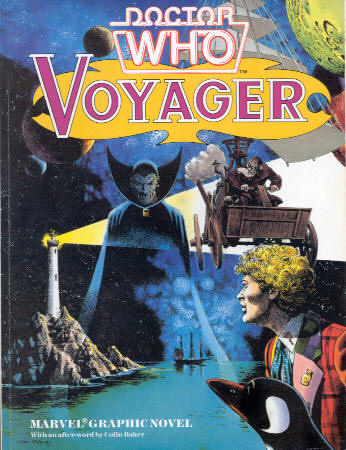
The cover for a collection of one of John Ridgway’s most popular Doctor Who strips, Voyager, written by Steve Parkhouse
IAN: Turning to Doctor Who, I think I’m right in saying that when you started drawing Colin Baker and Sylvester McCoy, you had not seen them on TV. How did you go about capturing their characters?
JOHN: I certainly hadn’t seen Colin when I started to draw the strip and I had only two rather poor newspaper pictures to work from. If you see the first two episodes I drew, I thought he was wearing a tartan coa! Once he appeared on TV more pictures became available.
I found that copying faces from photographs was difficult at first, but having drawn a face a few times it started to become easier.
The problem with trying to draw a comic around a known actor is that there are rarely photographs with the right expression, angle or lighting, so I had to learn to create Colin’s face as I required it.
The real problem came when Peri came into the stories. When you draw a man’s face, there’s a certain amount of leeway. An extra line on the forehead, a stronger line under the eyes or on either side of the mouth is acceptable. When you draw a woman’s face you have to be far more precise or the drawing becomes less than flattering.
At that time I realised that if I was drawing two of the characters from photographs I should probably draw the other characters from photos too. I started to use Fairburn’s reference books and now use them all the time.
I can’t honestly remember if I was short of reference for Sylvester’s face, but Sylvester has a face that is easily caricatured!
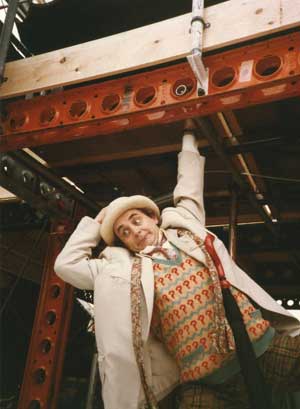
One of the reference pictures taken during recording of The Greatest Show in the Galaxy.
[John Freeman notes: “Sylvester McCoy actually posed for two photograph sessions for reference for the comics artists on Doctor Who Magazine – clambering scaffolding during a break in shooting of The Greatest Show in the Galaxy, and a more dignified session during a recording break in the sweltering heat of shooting his final regular story, Survival“].
IAN: You did some superb Dan Dare work for the new Eagle. Were you determined to capture the spirit of the original strips and how did you go about achieving this?
JOHN: I had studied Frank Hampson’s work on “Dan Dare” very closely over the years and, if I need to, I can do a reasonable representation of his style for a couple of pictures (it would be very difficult to maintain).
I also saw Keith Watson’s work when “Dan Dare” was relaunched. Of all the other artists who worked on the character, Keith came the closest to the appearance and feel of the original.
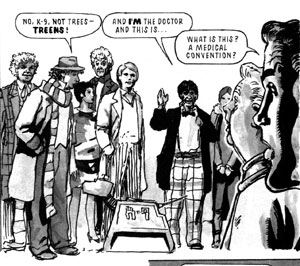
A panel from John’s pages for the 1991 Comic Relief Comic, in which Dan Dare meets Doctor Who. (By even looking at this image you are of course completely obliged to donate some money to Comic Relief!). Script by Dan Abnett.
I talked to him about what he was doing and knew he was not able to keep up with three pages per week, so I asked him if he minded me applying as one of the fill-in artists. I knew if anyone could recreate the original Dan Dare, Keith he could. I wanted to carry over the work as I felt Keith would be doing it.
The best colour work on the original Dan Dare was in “The Man from Nowhere“, Rogue Planet, and “Reign of the Robots“. I tried to use the colours Frank had used. This didn’t quite match Keith’s work – probably because Keith was completely colour-blind!
My style is looser than Keith’s, but I think this makes my work similar to the approach of Harold Johns.
I only drew two “Dan Dare” stories for the 1980s Eagle and was rather unhappy with the results. There had been efforts to change the details in the strip. Keith (being the acknowledged expert on Dan Dare) was able to resist these changes to a large extent, but I wasn’t in the same position.
In the first story I was told to draw a space ship like a space shuttle and the characters had to sit upright (the pilot usually lay on his front on a couch). The second story (drawn for a special) was very poor. I rewrote all of the dialogue – especially Digby’s – as it didn’t resemble a Lancashire accent (I live five miles from Wigan where Digby is supposed to live). In the story, Lex O’Malley was suddenly transferred from Royal Navy to Space Fleet, a space ship was sucked up by an interstellar vacuum cleaner (how a vacuum cleaner works in a vacuum, I don’t know), and the writer seemed to think that a light year was a measure of time rather than distance.
IAN: I was looking at some of your Commando work recently. How do you think that this title has lasted so long?
JOHN: Commando books established its readership a long time ago and has managed to retain it. The stories are of a high standard (irrespective of the quality of the artwork). They’re well researched and as accurate as possible. I receive considerable reference material to work from – I’ve never had a fraction of the amount of material from any other company. They are not over the top on violence and the heroes and villains are easily recognised. The heroes would usually make good role models (many of the heroes have the same sort of character as Dan Dare). The style of story-telling (pictures connected by a large amount of description in captions) allows a complex story to be told in a short space – they are a good read.
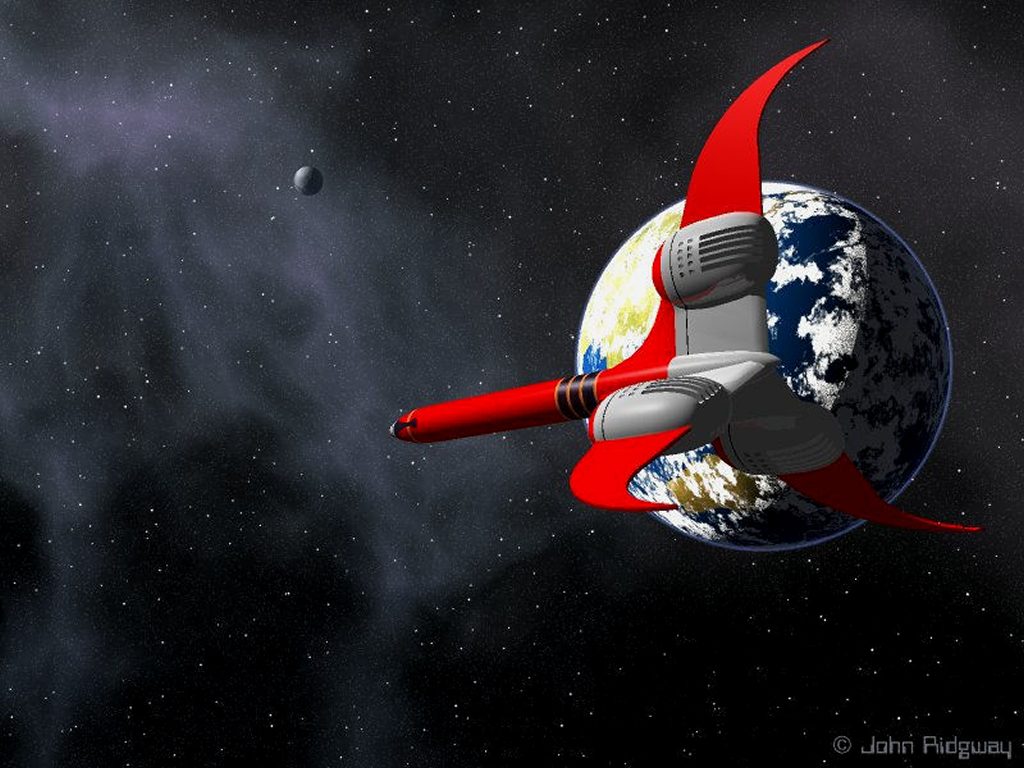
Constantly updating his skills and embracing new technology with gusto, this image, Crypt, was created in CyberMotion using a background created in POVRay.
IAN: Can you tell us a little bit about your new project, Eureka?
JOHN: Eureka is a children’s magazine some people I have been working with have been trying to get off the ground for a considerable amount of time. Basically, it would have the same philosophy (but not necessarily the same appearance) as the Eagle. It is aimed at eight to 13 year olds although the stories would be of a standard that could be appreciated by adults.
The man behind the concept is named Derek Lord.

Derek Lord photographed by Edmond Terakopian in 2001. “Mr Lord was a joy to meet and a joy to photograph,” Edmond recalls. Photograph used with kind permission.
I was amused to read in your fanzine that Barrie Tomlinson used his own name to personalise the editorship of his comics. Derek was the editor of the original Eagle, although Marcus Morris’s name was used as editor. Derek has been in children’s publishing all his life. He is now retired but, like me, he sees that there is a gap in the market for a children’s comic.
I do not subscribe to the notion that comics were driven out of business by video games. I think kids have the money to buy and read a decent comic costing £1 to £1.50. Once latched into it, they will continue to buy it.
Video games cost anything up to £50 and don’t come out every week. Comics and video games can exist side by side, just as comics and playing football, cricket, marbles and conkers existed side by side when I was a boy – they are not mutually exclusive.
The reason British comics have failed is that this country was swamped by American comics at a time when British comics were black and white, and sloppily written and drawn. However, American comics are now only available in specialist shops where they are having difficulty attracting new readers. A decent British comic magazine, readily available in newsagents, could sell.
For myself, I want to produce a space story set at the end of this century, using computer generated images for spacecraft etc. The central characters are Frank Rivington and Julia Pike of the UN Interplanetary Survey Corps. The background is as factual as possible.
A second strip is “Ocean Interpol” – a strip that ran in the Daily Express for a short time. We also have “Hadrian’s Heroes”, cutaway drawings by Graham Bleathman and John Batchelor, and text features. Peter Jackson would also be producing work.
We’ve tried to interest people in a weekly or a monthly to no avail. We are now looking at the possibility of a supplement in a weekly newspaper. Everything is being designed so that strips and articles can be repackaged as albums. Proost – a Belgian publisher – has expressed interest in publishing foreign editions. We are working with Imagineering, a company that produces prototypes for toys.
The whole thing could be a major publishing venture with a great number of spin-offs if only there were someone in this country who had the business acumen of the Americans and the money and vision to see it through.
Since the days of Warrior, there have been a lot of fans who have become writers and have aimed their stories at people of their own age. This isn’t what Eureka is about. I think it is important that the comic is produced for children.
This does not mean writing down to children – the Harry Potter books show that children’s books can appeal to adults.
IAN: Do you think Eagle could ever return?
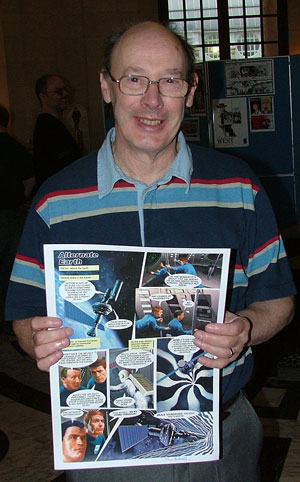
John Ridgway with a page of his strip Alternate Earth at the 2006 Lancaster Comics Festival. Photo: Jeremy Briggs
JOHN: Anything is possible, I suppose, but the experience we have had with Eureka show that chances are rather remote. Existing publishers don’t think a comic can succeed so they won’t invest. DC Thomson and Egmont aren’t interested in paying for top quality work. DC Thomson won’t produce a new comic for this country but they will do editorial packaging for comics in Germany (there is no financial risk involved).
I read once that [IPC Managing Editor] John Saunders is alleged to have believed that Frank Hampson was lazy because he could only produce one page of artwork a week. If this is true – an attitude of quantity over quality – it shows a horrific lack of appreciation of what goes into producing a page of artwork. Take an American comic, for instance. This has approximately 24 pages of artwork per month – six pages per week. But the work is split between penciller, inker and colourist, so each man is producing the equivalent of two pages per week. These pages are less than half the area in size of one of Frank Hampson’s pages and contain only a fraction of the detail – small wonder Frank had an assistant.
2000AD contains a lot of fine quality artwork but artists cannot maintain the pace of producing an episode of four to six pages of full-colour artwork per week, so there are several artists working on separate stories. In terms of time, this is the same as having the same artists all working together on each episode.
The only difference is that inconsistencies of style and interpretation creep in. The consistency of detail in Frank Hampson’s “Dan Dare” was one of the features that helped to make the strip real for the readers. Space Fleet HQ and the controls of a spaceship were as real as the inside of the Vic and Rover’s Return in the TV soaps.
IAN: Any thoughts on the future of British comics?
JOHN: As things stand, British comics are slowly dying. American comics are only on sale in specialist shops where they cannot attract new readership. DC Thomson doesn’t think of bringing out new comics so if Commando ever becomes unprofitable it will be cancelled and won’t be replaced. 2000AD has grown older with its audience – if this trend continues, it will fail to attract new readership and eventually have to be cancelled as existing readers fall away. Other comic companies are producing kiddies’ comics.
There is virtually nothing to bridge the gap between the kiddies’ comics and 2000AD.
I don’t want to see comics die. As a child, they gave me a tremendous amount of pleasure. This is one of the reasons I am prepared to invest my time on Eureka, which should bridge that gap.
If Eureka can be got off the ground and becomes a success others will follow. If it can’t, I’ll eventually finish a story and put it on CD, advertise it and sell individual copies. I should then also be in a position to sell it to Proost who, hopefully, can make a go of it. It will take a long time but I’ve nothing better I want to do!
IAN: John Ridgway, thank you very much.
Since this interview was first published in 2003, the Eureka project has sadly been abandoned after Derek Lord died in September 2004. (John Ridgway paid tribute to him on downthetubes at the time). At the time this interview was first published John wass offering plenty of support to Spaceship Away, a high quality magazine publishing new Dan Dare and other SF comic adventures.
COMMANDO CHECKLIST – As at March 2007
Checklist provided by Jeremy Briggs
546 April 1971 MUSTANG ACE
572 August 1971 UPSIDE DOWN ACE (+ 1604)
594 October 1971 TORPEDO STRIKE (+ 1675)
625 February 1972 ATTACK BY NIGHT (+ 1724)
650 May 1972 THE TIN GRASSHOPPER (+ 1796)
669 August 1972 DESTROYER
688 October 1972 WARLORD
700 December 1972 MUSTANG PATROL (+ 1859)
718 February 1973 FIVE FATHOM FURY (+ 1891)
748 June 1973 WEEKEND WARRIORS
769 August 1973 THE TRAIL OF THE GOLDEN SAMURAI
798 December 1973 THE JAWS OF DEATH (+ 2067)
818 February 1974 REVENGE OF THE PHANTOM (+ 2188)
864 August 1974 COUNTERSPY
896 December 1974 NO MAN’S LAND (+ 2180)
933 March 1975 MATILDA ON THE MARCH (+ 2259)
972 October 1975 RUN FOR YOUR LIFE
1021 April 1976 LAIR OF THE HAWK (+ cover)
1033 May 1976 SUPERFORT! (cover only)
1054 August 976 HERE COMES TROUBLE (+ 2388)
1098 January 1977 JUNGLE EXPRESS (+ cover)
1134 June 1977 OPEN FIRE!
1170 October 1977 FRONTLINE SAPPER (+ cover)
1204 March 1978 JAVA PATROL
1242 July 1978 BEAUFIGHTER! (+ 2540)
1282 December 1978 JET STRIKE
1322 May 1979 FIGHT IN THE NIGHT
1385 January 1980 ONE WAS MISSING
1391 February 1980 BLACK ARROW (cover only)
1415 May 1980 BOMBS GONE!
1448 September 1980 THE BULLDOG BREED
1490 February 1981 ADVANCE! (+ 2836)
 1517 June 1981 RESCUE! (cover only)
1517 June 1981 RESCUE! (cover only)
1525 July 1981 THE ROAR OF THE GUNS (+ 2860)
1565 December 1981 THE LINE SHOOTER (+ 2715)
1599 April 1982 MYSTERY OF THE OCEAN (+ 2739)
1604 May 1982 UPSIDE DOWN ACE (R 572)
1630 August 1982 JUNGLE RAIDERS
1654 November 1982 DEPTH CHARGES AWAY!
1675 February 1983 TORPEDO STRIKE (R 594)
1698 April 1983 GALLANT FOE
1724 August 1983 ATTACK BY NIGHT (R 625)
1796 May 1984 THE TIN GRASSHOPPER (R 650)
1844 November 1984 WARLORD (R 688)
1859 January 1985 MUSTANG PATROL (R 700)
1891 May 1985 FIVE FATHOM FURY (R 718)
1964 February 1984 WEEKEND WARRIORS (R 748)
2067 March 1987 THE JAWS OF DEATH (R 798)
2180 May 1988 NO MAN’S LAND (R896)
2188 June 1988 REVENGE OF THE PHANTOM (R 818)
2259 March 1989 MATILDA ON THE MARCH (R 933)
2388 July 1990 HERE COMES TROUBLE (R 1054)
2540 February 1992 BEAUFIGHTER! (R 1242)
2660 May 1993 THE BULLDOG BREED (R 1448)
2715 December 1993 THE LINE SHOOTER (R 1565)
2739 March 1994 MYSTERY OF THE OCEAN (R 1599)
2820 January 1995 DEPTH CHARGES AWAY! (R 1654)
2836 March 1995 ADVANCE! (R 1490)
2860 June 1995 THE ROAR OF THE GUNS (R 1525)
2975 August 1996 ADAM’S ARMY
3009 December 1996 NIGHT OF RECKONING
3041 April 1997 BUSH WAR ( + cover)
3159 July 1998 BIRD DOG ( + cover)
3261 August 1999 EAGLE ON THE SHORE ( + cover)
3298 December 1999 PROGRAMMED TO KILL ( + cover)
3318 March 2000 DEAD MAN’S DIARY ( + cover)
3346 June 2000 OUTLAW! ( + cover)
3362 August 2000 HONOUR! ( + cover)
3370 September 2000 THE EAGLE AND THE WOLF ( + cover)
3384 November 2000 SAVE THE EAGLE! ( + cover)
3406 February 2001 HARAX THE HERO ( + cover)
3413 March 2001 ARMY OF HEROES ( + cover)
3422 April 2001 VALLEY OF THE GLADIATORS ( + cover)
3439 June 2001 WAR IN THE WILDERNESS ( + cover)
3449 July 2001 DEFENDERS OF THE TREASURE ( + cover)
3462 September 2001 TOP SECRET TUNNEL ( + cover)
3471 October 2001 VIKING SLAVE ( + cover)
 3482 November 2001 FREE TO FIGHT! ( + cover)
3482 November 2001 FREE TO FIGHT! ( + cover)
3490 December 2001 VIKING CURSE ( + cover)
3506 February 2002 CURSED! ( + cover)
3521 April 2002 TERROR TIME ( + cover)

John’s cover for Commando #3530. Art © DC Thomson
3530 May 2002 MOUNTAIN WARFARE ( + cover)
3546 July 2001 UNEXPLODED BOMB! ( + cover)
3559 September 2002 ICE-COLD WAR ( + cover)
3575 November 2002 ZONE OF FEAR ( + cover)
3594 January 2003 CONDEMNED TO DIE ( + cover)
3622 May 2003 ARCTIC KILLER ( + cover)
3634 June 2003 WARRIOR HERO ( + cover)
3640 July 2003 SEEK THE SWORD ( + cover)
3662 October 2003 WORLD’S END ( + cover)
3672 November 2003 ROBOT MENACE ( + cover)
3688 January 2004 ROCKET PATROL ( + cover)
3714 April 2004 KILLER CAT ( + cover)
3775 December 2004 THE DEVIL’S HORSEMEN ( + cover)
3805 April 2005 DRAGON RIDERS! ( + cover)
3815 May 2005 REVENGE OF THE DRAGON RIDERS!( + cover)
3830 July 2005 H-BOAT HUNT ( + cover)
3862 November 2005 DUEL OF GIANTS ( + cover)
3888 February 2006 TIME FOR FEAR ( + cover)
3903 April 2006 THE FINAL FLIGHT ( + cover)
3914 May 2006 DANGER IN THE EAST ( + cover)
3928 July 2006 JOURNEY’S END ( + cover)
[amazon_link asins=’1582400601,B0714QDGJG,B016LBRDTM,1905239718′ template=’ProductCarousel’ store=’downthetubes’ marketplace=’UK’ link_id=’0c045599-4032-41cc-a9a4-3b4895b12a28′]
Dan Dare © Dan Dare Corporation | Doctor Who © BBC | Commando © DC Thomson